|
|
|
|
|
Oil On
Canvas, Real Flavor of Old Masters
|
|

|
ARTWORKS
INDEX
A B C D E F G H I J K L M N O P Q R S T U V W X Y Z |
ARTISTS
INDEX
A B C D E F G H I J K L M N O P Q R S T U V W X Y Z |
|
|
| | |
|
|
 |
FARINATI, Paolo -- Click Here
|
|
Italian painter, Veronese school (b. 1524, Verona, d. 1606, Verona)
Italian painter and draughtsman. He was the son of a painter, Giambattista, but probably trained in the workshop of Nicola Giolfino (Vasari). His earliest documented painting, St Martin and the Beggar (1552; Mantua Cathedral), was commissioned by Cardinal Ercole Gonzaga along with works by Battista dell'Angolo del Moro, Veronese and Domenico Brusasorci for Mantua Cathedral, newly restored by Giulio Romano. As is evident in his chiaroscuro and figure types, Farinati had absorbed certain Mannerist influences from the frescoes of scenes from the Life of the Virgin (1534) in the choir of Verona Cathedral, executed by Francesco Torbido to Giulio's design. Giolfino's eccentric style would also have encouraged Farinati to emphasize line over colour and to restrict his palette to rather opaque greys, browns, mauve and rust. His two-canvas Massacre of the Innocents (1556; Verona, S Maria in Organo) displays the muscular figures, sharp foreshortenings and posed attitudes of Mannerism and has a more polished finish than his earlier work. Its strong, plastic qualities are also evident in Christ Walking on the Water and the Supper of St Gregory (1558) in the choir of the same church. |
|
 |
Fanny Palmer -- Click Here
|
|
One of the premier artists and stone lithographers .
American , 1812-1876
|
|
 |
Faccini Pietro -- Click Here
|
|
Italian Painter, ca.1575-1602 |
|
|
|
 |
Eunice Pinney -- Click Here
|
|
American Folk Artist, 1770-1849
She was a self-taught artist who, from about 1809 to 1826, devoted part of her time to producing a wide range of subjects in watercolour: landscape, genre, historical, biblical, allegorical and literary. Her distinctive style is solid and robust, with a strong sense of contrast and design. Problems in creating realistic form are apparent: faces are largely expressionless, and figures are stocky and two-dimensional. However, these difficulties are compensated for by fresh vigorous colour, bold pattern, artful composition and varied subject-matter. Pinney displayed the primitive artist's tendency to borrow and model from the best sources at hand: The Cotter's Saturday Night |
|
|
|
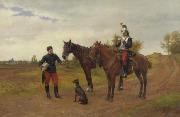 |
etienne Prosper Berne-Bellecour -- Click Here
|
|
1838-1910 |
|
 |
Erik Pauelsen -- Click Here
|
|
painted Ove Malling in 1700s |
|
 |
Enoch Wood Perry, Jr. -- Click Here
|
|
(1831-1915) was a painter from the United States.
Perry was born in Boston on July 31, 1831. His father was Enoch Wood Perry, and mother was Hannah Knapp Dole. His maternal grandparents were Samuel Dole and Katherine Wigglesworth. The family moved to New Orleans with his family as a teenager in 1848 and attended its public schools. After working several years as a clerk in a commission house, Perry began formal art education. In 1852 he went to Europe for four years and studied with Emanuel Leutze at the Desseldorf Academy, Thomas Couture in Paris, and in Rome.Perry served as the U.S. Consul to Venice between 1856 and 1858. Upon returning to America, he opened a studio in Philadelphia. |
|
|
|
 |
ELINGA, Pieter Janssens -- Click Here
|
|
Dutch Baroque Era Painter, 1623-ca.1682 |
|
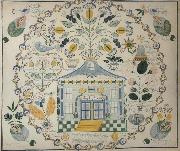 |
Eldress Polly Jane Reed -- Click Here
|
|
b.1818 d.1881
|
|
 |
Eilif Peterssen -- Click Here
|
|
1852-1928
was a Norwegian painter. He attended the of Fredrik Eckersberg in Kristiania (now Oslo) in 1866 and 1870. After that, he studied painting briefly with Knud Bergslien at the Johan Fredrick Eckersberg School of Painting and left to go abroad in 1871. He studied at the School of Art of Copenhagen; in Karlsruhe (1871?C1873), where he was a student of Hans Gude; and, together with Hans Heyerdahl, in Munich under Wilhelm von Diez. He then studied in London, Paris, and Italy. After these travels, he returned to Norway and settled in Bærum. He made his debut at the Høstutstillingen (Autumn Exposition) in Kristiania in 1882. He was a profound connoisseur of European art and was later associated groups such as Lysaker, the painters of Fleskum and those of Skagenpainters, as well as with individual artists like August Eiebakke, Kitty Kielland and Harald Oskar Sohlberg. In Norway, he is also known as the designer of the coat of arms of Norway, adopted when the country separated from Sweden in 1905 to become an independent country. This version was used for official government purposes until 1937, when it was replaced by a new version. Nonetheless, Peterssen's design is still used for the royal coat of arms and for the royal flag. In addition to his canvasses, he collaborated on the decoration of the Tourist Hotel in Holmenkollen in 1889. In the same year, he painted the murals "The Wanderers of Emmaus" in the Church of Tanum in Bærum and "Jesus in the Garden of Gethsemane" in the Church of the Cross, Bergen. |
|
 |
Egbert van der Poel -- Click Here
|
|
Egbert van der Poel (Delft, 1621 - Rotterdam, 1664) was a Dutch Golden Age genre and landscape painter, son of a Delft goldsmith.
He may possibly have been a student of Esaias van de Velde and of Aert van der Neer. According to the RKD he was the brother of the painter Adriaen Lievensz van der Poel and a student of Cornelis Saftleven in Rotterdam. Van der Poel was registered with the Guild of St Luke in Delft on October 17, 1650, where he is listed as a landscape painter. In 1651 van der Poel married Aeltgen Willems van Linschooten in Maassluis, near Rotterdam. His most famous paintings depict the Delft gunpowder explosion of October 12, 1654 and its aftermath; he and his wife were living in the area at the time. Egbert and Aeltgen van der Poel had a son and three daughters. He died in Rotterdam in 1664. |
|
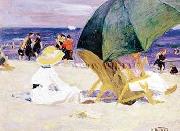 |
Edward Henry Potthast Prints -- Click Here
|
|
American Impressionist Painter, 1857-1927
Edward Henry Potthast (1857 ?C 1927) was an American Impressionist painter.
He was born in Cincinnati, Ohio. From June 10, 1879 to March 9, 1881 he studied with Thomas Satterwhite Noble. He later studied at the Royal Academy in Munich with the American-born instructor Carl Marr. After returning to Cincinnati in 1885 he resumed his studies with Noble. In 1886 he departed for Paris, where he studied with Fernand Cormon. In 1895 he relocated to New York City and remained there until his death in 1927. |
|
 |
Edvard Petersen -- Click Here
|
|
(4 February 1841 - 5 December 1911) was a Danish painter. He also designed the Stork Fountain on Amagertorv in Copenhagen
From 1851 he attended the Royal Danish Academy of Fine Arts. In the 1860s and 1870s he painted romantic landscape paintings under influence of Vilhelm Kyhn. He was a close friend of fellow painter Theodor Philipsen and together they went on several travels, including two stays in Italy between 1875 and 1880 and a visit to France.The friendship did not seem to influence Petersen's rather conservative style of painting and his works from the times abroad are generally traditional paintings of local life.
In the 1880s Petersen painted a number of figure paintings of street life in Copenhagen under influence of French Realism. His most famous paintings are Emigrants on Larsens Plads (1880) and A Return, the America Liner at Larsens Plads (894).
With his Stork Fountain proposal, Petersen won the competition for the design of a new fountain on Amagertorv in Copenhagen in 1888. The sculptor Vilhelm Bissen moulded the birds and the fountain was inaugurated in 1904
|
|
 |
Edouard Debat Ponsan -- Click Here
|
|
French Academic Painter, 1847-1913
1847-1913.French painter. He trained in Toulouse and later at the Ecole des Beaux-Arts in Paris under Alexandre Cabanel. In 1873 he won second place in the Prix de Rome and in 1874 the Prix Troyon of the Institut. From the Institut he received a bursary that enabled him to visit Italy. In 1870 he made his debut at the Salon under the name Ponsan-Debat and afterwards exhibited there such genre and history paintings as Jephthah's Daughter (1876; Carcassonne, Mus. B.-A.). He also executed religious works, some of which were for churches and cathedrals: he painted St Paul before the Areopagus (1877) for the church at Courbevoie and the Pity of St Louis for the Dead (1879) for the cathedral at La Rochelle. From 1880 Debat-Ponsan was the name under which he exhibited. The Massage (1883; Toulouse, Mus. Augustins) shows a white female nude massaged by a negress, and the subject attracted comment from contemporary critics. He also painted a number of landscapes, including Corner of the Vineyard (1888; Nantes, Mus. B.-A.). These were painted in a style similar to that of Jules Bastien-Lepage and, when they included figures, were often sentimental. His reputation depended, however, on his portraits, which are distinguished by their vigorous colour and precision, as seen in the portrait of Pouyer-Quertier (c. 1885; Rouen, Mus. B.-A.). Most notable was his portrait of General Boulanger (1887; untraced), which was shown at the Salon of 1887 and was accepted in 1889 for the Exposition Universelle in Paris. Amid scandal, Debat-Ponsan withdrew it soon after the opening because he thought that the Exposition was badly organized and his painting was not shown to advantage. He refused the bronze medal awarded it by the jury. In later years, while producing such paintings as Christ on the Mountain (1889; Toulouse, Mus. Augustins), he increasingly responded to contemporary events in his work. |
|
 |
E.Phillips Fox -- Click Here
|
|
Australian Naturalist Painter, 1865-1915
Australian painter and teacher. From 1878 to 1886 he trained at the National Gallery of Victoria Art Schools, Melbourne, and in 1887 left to study in Europe. In Paris he attended the Academie Julian and was taught by Jean-Leon Gereme at the Ecole des Beaux-Arts and by the American artist T. Alexander Harrison (1853-1930). He was involved with the plein-air artists at Etaples, Pas-de-Calais, and in Brittany and also visited Giverny, where from 1883 Monet was living. By 1890 he had moved to England, to the artists' colony at St Ives, Cornwall. In 1892 he returned to Melbourne where he chiefly painted portraits and landscapes. He was a member of the Victorian Artists' Society, exhibiting with them between 1892 and 1900. In 1893 he established the lively Melbourne Art School with Tudor St George Tucker (1862-1906). There an academic training coupled with a modified Impressionist technique was taught, as can be seen in Fox's painting the Art Students . In 1901 he left for London, having been commissioned by the Trustees of the National Gallery of Victoria to paint the Landing of Captain Cook at Botany Bay. After his marriage in 1905 to the artist Ethel Carrick, he and his wife settled in Paris and remained there until 1913. |
|
 |
E. Phillips Fox -- Click Here
|
|
Emanuel Phillips Fox (1865-1915) was an Australian Naturalist painter.
|
|
 |
DUPUYS, Pierre -- Click Here
|
|
French painter (b. 1610, Montfort l'Amaury, d. 1682, Paris).
|
|
 |
DUMOUSTIER, Pierre -- Click Here
|
|
French painter (c. 1540 - after 1600) |
|
 |
Domenico Puligo -- Click Here
|
|
(1492-1527) was an Italian painter of the Renaissance, active in Florence. His real name was Domenico di Bartolommeo Ubaldini.
He was trained by Ridolfo Ghirlandaio, but acquired a style consistent with his contemporary Andrea del Sarto. He painted a Vision of Saint Bernard altarpiece, now in Walters' Gallery in Baltimore. He was also in demand for portraits. He is featured in Giorgio Vasari's Vite or biographies of artists. He excelled as a portrait painter. He befriended Andrea del Sarto ane worked with Ridolfo Ghirlandaio. His brother, Jacone Puligo was also a Renaissance painter.
|
|
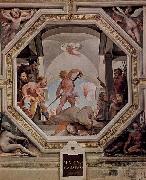 |
Domenico di Pace Beccafumi -- Click Here
|
|
(1486?CMay 18, 1551) was an Italian Renaissance-Mannerist painter active predominantly in Siena. He is considered one of the last undiluted representatives of the Sienese school of painting.
Domenico was born in Montaperti, near Siena, the son of Giacomo di Pace, a peasant who worked on the estate of Lorenzo Beccafumi. Seeing his talent for drawing, Lorenzo adopted him, and commended him to learn painting from Mechero, a lesser Sienese artist. In 1509 he traveled to Rome, but soon returned to Siena, and while the Roman forays of two Sienese artists of roughly his generation (Il Sodoma and Peruzzi) had imbued them with elements of the Umbrian-Florentine Classical style, Beccafumi's style remains, in striking ways, provincial. In Siena, he painted religious pieces for churches and of mythological decorations for private patrons, only mildly influenced by the gestured Mannerist trends dominating the neighboring Florentine school. |
|
 |
dioscoro teofilo puebla tolin -- Click Here
|
|
dioscoro teofilo puebla tolin(1831 to1901),who studied in madrid and rome,worked in the tradition fo historicism,asubgenre of history painting,which focused on the interplay of religious pride,patriotism ,and sntions of glory.tolin s technical style is referred to as eclecticism for its wide ranging,and often superficial ,borrowing from euopean techniques and visual trends. paintings in this genre were often funded by official organizations and art academies,which treated them as opportuities for propagandistic interpretations of history.the first landing of christopher columbus in america provides on shortage of drama |
|
|
|
dioscoro teofilo de la puebla tolin -- Click Here
|
|
dioscoro teofilo de la puebla tolin(1831 to1901),who studied in madrid and rome,worked in the tradition fo historicism,asubgenre of history painting,which focused on the interplay of religious pride,patriotism ,and sntions of glory.tolin s technical style is referred to as eclecticism for its wide ranging,and often superficial ,borrowing from euopean techniques and visual trends. paintings in this genre were often funded by official organizations and art academies,which treated them as opportuities for propagandistic interpretations of history.the first landing of christopher columbus in america provides on shortage of drama |
|
 |
Dickinson, Preston -- Click Here
|
|
American Precisionist Painter, 1891-1930
American painter, b. New York City. In New York he studied at the Art Students League. From 1910 to 1915 he traveled in Europe, returning often later in life. His still lifes and landscapes in oil and watercolor are built up of highly colorful planes. |
|
 |
De Winter Pharaon -- Click Here
|
|
French realist painter , 1849-Little 1924
|
|
 |
David van der Plas -- Click Here
|
|
David van der Plas (1647-1704), was a Dutch Golden Age portrait painter.
David van der Plas became famous as a portrait painter, and his most illustrious patron was Cornelis Tromp. In 1684 he married Cornelia van der Gon of Haarlem, the daughter of the castellan (kastelein) of the Oude Doelen, the meeting quarters of the Haarlem schutterij (the building currently houses the Stadsbibliotheek Haarlem). David van der Plas' brother-in-law was the painter Govert van der Leeuw and his pupil was Jacob Appel.
His wife Cornelia van der Gon was the rich heiress of the Amsterdam architect Adriaan Dortsman (ca. 1636-1682), who designed the round Lutheran church on the Singel. The marriage was childless, and Cornelia spent her time on her doll houses, which Dortsman had helped design and which Van der Plas helped decorate. The landscape painter Jan Wijnants also painted miniatures for these doll houses. Cornelia died in 1701, and after the death of Van der Plas, the doll houses were sold at auction to Sara Rothe, who used them to decorate her own doll houses. |
|
 |
CUYP, Aelbert -- Click Here
|
|
Dutch Baroque Era Painter, 1620-1691
Painter and draughtsman, son of (1) Jacob Cuyp. One of the most important landscape painters of 17th-century Netherlands, he combined a wide range of sources and influences, most notably in the application of lighting effects derived from Italianate painting to typical Dutch subjects. Such traditional themes as townscapes, winter scenes, cattle pieces and equestrian portraits were stylistically transformed and given new grandeur. Aelbert was virtually unknown outside his native town, and his influence in the 17th century was negligible. |
|
 |
COUSTENS, Pieter -- Click Here
|
|
Flemish painter (active 1453-1487 in Bruges and Brussels) |
|
 |
CORNELIUS, Peter -- Click Here
|
|
1824-1874,German composer. Trained as actor and violinist, and friend of artists, poets and writers, he devoted himself to music from the 1840s, finding inspiration in Liszt and the New German School at Weimar in 1852. His first mature works were the lieder opp. 1 and 2 and the song cycle Trauer und Trost op.3, followed by the comic opera Der Barbier von Bagdad (1855-8); all show his literary skill, refreshing simplicity and musical independence from the Liszt circle. In Vienna (1859-65), he wrote his second opera Der Cid and enjoyed fruitful relationships with Brahms, Carl Tausig and above all Wagner, who summoned him to Munich in 1865 as his private repetiteur and teacher at the Royal School of Music. His third opera Gunlöd was never finished. He continued to write poetry and essays defending Wagner and Liszt and translated vocal works by Pergolesi, Berlioz, Liszt and others. Although he revered Wagner, he stood ethically and artistically apart, his work (especially Der Barbier) thus representing an original achievement. |
|
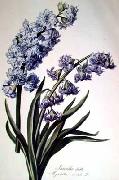 |
Cornelis van Spaendonck Prints -- Click Here
|
|
Dutch 1756-1840
Cornelis van Spaendonck (7 December 1756 - 22 December 1839) was a Dutch painter who was a native of Tilburg. Spaendonck initially worked under artist Guillaume-Jacques Herreyns (1743-1827) in Antwerp, and in 1773 moved to Paris to study and work with his brother, floral painter G??rard van Spaendonck (1746-1822). From 1785 to 1800, Cornelis van Spaendonck was head of the porcelain works at S??vres. Due to difficulties encountered as an administrator, he was relieved of his directorship in 1800, but remained at S??vres as a designer and artist until 1808.
In 1789 Spaendonck became a member of the Acad??mie des Beaux Arts. He painted throughout his lifetime, and displayed his works at the Salons of Paris until 1833. Most of Spaendonck's works were created with oils and gouache, and he is remembered for his lush still-lifes of flowers. Among his paintings were subjects such as De Fleurs Et Fruits, Vase De Fleurs, Bouquet De Different Fleurs, Fleurs Du Jardin, Corbeille Fleurs, et al. At his death in 1840 there were 29 paintings in his studio, which were auctioned soon afterwards. |
|
 |
Cornelis van Poelenburch -- Click Here
|
|
(1594 - 12 August 1667) was a Dutch Golden Age landscape painter.
Though his birthplace is unknown, a signed document survives in Utrecht where he is listed as six years old and the son of Simon van Poelenburch, a Catholic canon in Utrecht.He initially trained with Abraham Bloemaert, and his earliest signed paintings are from 1620.He traveled to Rome where he was influenced by Adam Elsheimer and became a founding member of the Bentvueghels. He counted a few cardinals under his patrons, and was called to England by Charles I of England, for whom he made small cabinet pieces. He returned to Utrecht where he later died just a few years after his old teacher Abraham Bloemaert.He painted mostly small landcapes with mythical or religious figures or passages, in a style that would later be evident in some of the works of Claude Lorraine.
His "most important and successful" pupils were Daniël Vertangen, Dirck van der Lisse, François Verwilt, and Jan van Haensbergen. Arnold Houbraken claimed that his best pupil was Joan vander Lis from Breda (not Dirk vander Lis from The Hague). Houbraken then mentioned Vertangen, Verwilt, Warnard van Rysen from Bommel, and Willem van Steenree, a nephew. The RKD also mentions Laurens Barata. |
|
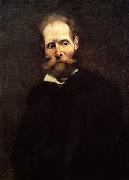 |
Columbano Bordalo Pinheiro -- Click Here
|
|
(Lisbon, 21 November 1857 - Lisbon, 6 November 1929), who is usually referred to as Columbano, was a Portuguese Realist painter. Usually considered the greatest Portuguese painter of the 19th century, he has been compared to the likes of Wilhelm Leibl and Thomas Eakins.
Columbano was the son of a mediocre romantic painter, Manuel Maria Bordalo Pinheiro, and the younger brother of the great caricaturist, Rafael Bordalo Pinheiro. He became the leading painter of his generation and the master of realism in Portuguese painting, specializing in portraiture. He was disciple of his father, of the painter Miguel Ângelo Lupi and the sculptor Simões de Almeida. After attempting twice for a bursar to study abroad finally in 1881 the countess of Edla, second wife of D.Fernando would finance his study in France. There he studied the work of French naturalist, realist and impressionist painters, like Courbet, Manet and Degas without losing his distinctive style which is often gloomy and intimist. He joined the "Grupo do Leão" (The Lion's Group), a usual meeting of artists, writers and intellectuals in a Lisbon downtown restaurant called "Leão de Ouro" (The Golden Lion) in order to discuss aesthetic issues and proclaim Naturalism against the academic art of the time. The group also included Rafael Bordalo Pinheiro, Antenio da Silva Porto, Marques de Oliveira and Jose Malhoa. He painted portraits of some of the greatest names of Portuguese society and culture of his time like Jose Maria de Eça de Queiroz, Teefilo Braga, Raul Brandão and had great psychological accuracy in defining the personality of those depicted. His most famous portrait was that of the poet Antero de Quental in 1889. In this haunting work Columbano seems to have anticipated Antero's suicide.
Columbano was a well known Republican, so it wasn't surprising that after the Republic proclamation, in 1910, he was invited to design the flag of the new regime and was nominated director of the National Museum of Contemporary Art, currently the Chiado Museum, in Lisbon, of which he was in charge from 1914 to 1927. The best collection of his paintings is in the Chiado Museum, in Lisbon. He's also represented in some of the finest Portuguese museums, like the National Museum Soares dos Reis, in Porto.
|
|
 |
COECKE VAN AELST, Pieter -- Click Here
|
|
Flemish Northern Renaissance Painter, ca.1502-1550
South Netherlandish painter, architect, and linguist. After extensive travels he settled in Antwerp, where he published (1539) a Flemish translation of Vitru-vius's De Architectura and (1539?C53) Serlio's multi-volume treatise into Flemish, French, and High German.
|
|
 |
CODDE, Pieter -- Click Here
|
|
Dutch Baroque Era Painter, 1599-1678
Dutch painter and poet. Frans Hals was once thought to have been his teacher, but there is no evidence for this. It is possible that Codde studied with a portrait painter, perhaps Barent van Someren (1572/3-1632) or Cornelis van der Voort (1576-1624), since most of his earliest works, from the period 1623-7, seem to be portraits. His earliest known dated work is the Portrait of a Young Man (1626; Oxford, Ashmolean), which precedes by a year his earliest dated genre piece, the Dancing Lesson (1627; Paris, Louvre). He was particularly productive in the 1620s and 1630s, painting mainly interior genre scenes. After the mid-1640s only portraits and a few history paintings, such as the Adoration of the Shepherds |
|
 |
COCK, Paul de -- Click Here
|
|
Flemish painter (1724-1801). |
|
 |
Clara Peeters -- Click Here
|
|
Clara Peeters (1594 - c. 1657) was a Flemish painter noted for painting still lifes, particularly of breakfast scenes and florals.
Few details of her life are known. She was baptized in Antwerp in 1594, and married there in 1639. She is known to have lived in Amsterdam and The Hague. Her first known work was dated 1608, when she was 14. The quality of this work reveals a master teacher, and scholars believe she was influenced by Osias Beert. He was probably also an influence on the flower paintings of her contemporary, Catarina Ykens I (1608/1618 - 1666/1685), who was the wife of Frans Ykens, a pupil of Beert's. Clara Peeters's last painting was dated 1657, and is now lost. The circumstances of her death are unknown.
|
|
 |
CLAESZ, Pieter -- Click Here
|
|
Dutch Baroque Era Painter, ca.1597-1660
Dutch painter of German birth. He apparently spent his entire career in Haarlem, where he specialized in still-life paintings. Well over 100 works survive, dating from 1621 to 1660. Most of his pictures are dated and monogrammed PC. Since those initials were shared by the Antwerp still-life painter CLARA PEETERS |
|
 |
CLAEISSENS, Pieter the Younger -- Click Here
|
|
Flemish Northern Renaissance Painter, ca.1500-1575 |
|
|
|
 |
Circle of Pellegrino Tibaldi -- Click Here
|
|
painted The Meeting of Mary and Elizabeth in the Presence of St. Jerome, St. Joseph and Others in 1550 - 1600
|
|
 |
CHRISTUS, Petrus -- Click Here
|
|
Netherlandish Northern Renaissance Painter, ca.1410-1473 |
|
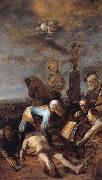 |
Christopher Paudiss -- Click Here
|
|
German Baroque Era Painter, 1630-1666, was a Bavarian Baroque painter and a student of Rembrandt van Rijn. After working in Stuttgart (1656), Prague, Dresden (1659-60), Vienna and Salzburg, he stayed his last four years in Freising where he worked for Furstbischof Albrecht Sigismund von Bayern. He was married twice. His paintings and frescoes show dark pictures of everyday life. |
|
 |
Christoph Paudiss -- Click Here
|
|
German,Christoph Paudiss, ca.1618-1666
|
|
 |
Christoffel Pierson -- Click Here
|
|
Christoffel Pierson (1631-1714) was a Dutch Golden Age painter.
|
|
 |
Christine de Pisan -- Click Here
|
|
French poet and arguably the first female author.
1364-1430
French writer. She was the daughter of an astrologer to Charles V and the wife of a court secretary and took up writing to support her children when she was widowed, producing 10 volumes of graceful verse, including ballads, rondeaux, lays, and complaints, many in the courtly-love tradition. Some works, both poetry and prose, champion women, notably The Book of the City of Ladies (1405). |
|
 |
Chevannes, Pierre Puvis de -- Click Here
|
|
French Symbolist Painter, 1824-1898 |
|
 |
Charles-Amedee-Philippe van Loo -- Click Here
|
|
(25 August 1719 -15 November 1795) was a French painter of allegorical scenes and portraits.
He studied under his father, the painter Jean-Baptiste van Loo, at Turin and Rome, where in 1738 he won the Prix de Rome, then at Aix-en-Provence, before returning to Paris in 1745. He was invited to join the Academie Royale de Peinture et de Sculpture in 1747, and that year he married his cousin Marie-Marguerite Lebrun, daughter of the painter Michel Lebrun (died 1753).
Among his brothers were the painters François van Loo (1708-1732) and Louis-Michel van Loo (1707-1771).
|
|
 |
Charles Wilson Peale -- Click Here
|
|
1741-1827
Charles Wilson Peale Galleries
Finding that he had a talent for painting, especially portraitures, Peale studied for a time under John Hesselius and John Singleton Copley. Friends eventually raised enough money for him to travel to England to take instruction from Benjamin West. Peale studied with West for two years beginning in 1767, afterward returning to America and settling in Annapolis, Maryland. There, he taught painting to his younger brother, James Peale, who in time also became a noted artist.
Peale's enthusiasm for the nascent national government brought him to the capital, Philadelphia, in 1776, where he painted portraits of American notables and visitors from overseas. His estate, which is on the campus of La Salle University in Philadelphia, can still be visited. He also raised troops for the War of Independence and eventually gained the rank of captain in the Pennsylvania militia by 1777, having participated in several battles. While in the field, he continued to paint, doing miniature portraits of various officers in the Continental Army. He produced enlarged versions of these in later years. He served in the Pennsylvania state assembly in 1779-1780, after which he returned to painting full-time.
Peale painted in the trompe l'oeil style,[1] and was quite prolific as an artist. While he did portraits of scores of historic figures (such as John Hancock, Thomas Jefferson and Alexander Hamilton), he is probably best known for his portraits of George Washington. The first time Washington ever sat for a portrait was with Peale in 1772, and there would be six other sittings; using these seven as models, Peale produced altogether close to 60 portraits of Washington. In January 2005, a full length portrait of "Washington at Princeton" from 1779 sold for $21.3 million dollars - setting a record for the highest price paid for an American portrait.
Peale had a great interest in natural history, and organized the first U.S. scientific expedition in 1801. These two major interests combined in his founding of what became the Philadelphia Museum, and was later renamed the Peale Museum.
This museum is considered the first. It housed a diverse collection of botanical, biological, and archaeological specimens. Most notably, the museum contained a large variety of birds which Peale himself acquired, and it was the first to display North American mammoth bones.
The display of the mammoth bones entered Peale into a long standing debate between Thomas Jefferson and Comte de Buffon. Buffon argued that Europe was superior to the Americas biologically, which was illustrated through the size of animals found there. Jefferson referenced the existence of these mammoths (which he believed still roamed northern regions of the continent) as evidence for a greater biodiversity in America. Peale's display of these bones drew attention from Europe, as did his method of re-assembling large skeletal specimens in three dimensions.
The museum was among the first to adopt Linnaean taxonomy. This system drew a stark contrast between Peale's museum and his competitors who presented their artifacts as mysterious oddities of the natural world.
The museum underwent several moves during its existence. At various times it was located in several prominent buildings including Independence Hall and the original home of the American Philosophical Association.
The museum would eventually fail in large part because Peale was unsuccessful at obtaining government funding. After his death, the museum was sold to, and split up by, showmen P. T. Barnum and Moses Kimball. |
|
 |
Charles Willson Peale -- Click Here
|
|
1741-1827
Painter and museum founder. After serving as a saddler's apprentice in Annapolis, MD, from 1754 to 1761, he worked at various trades, including painting signs and portraits. In 1766 some prominent Marylanders underwrote his studies in London with Benjamin West, from whom he absorbed the fundamentals of the British portrait tradition. Peale probably attended the informal life classes offered at St Martin's Lane Academy, precursor to the Royal Academy Schools, and drew from casts in the Duke of Richmond's collection in Whitehall. He visited the studios of such important British portrait painters as Joshua Reynolds, Francis Cotes and Allan Ramsay and studied the techniques of miniature painting, sculpture and engraving. In London he executed his first major commission |
|
 |
Charles Sprague Pearce -- Click Here
|
|
For other people named Charles Pearce, see Charles Pearce (disambiguation).
Charles Sprague Pearce (October 13, 1851 - May 18, 1914) was an American artist.
|
|
 |
Charles Rollo Peters -- Click Here
|
|
born in San Francisco in 1862 ,dead 1928 |
|
 |
Charles Poerson -- Click Here
|
|
French Painter, 1609-1667
He studied under his own father Charles Poerson (himself a former pupil of Simon Vouet) and under Noël Coypel. His notable works include "Dispute Between Neptune and Minerva" at Chateau de Fontainebleau, "Union of the Academie royale de Paris and the Academy of Saint Luke in Rome" at Versailles and participation in the decoration of the Hotel des Invalides. He was buried in San Luigi dei Francesi, Rome, in a tomb attributed to the sculptor Pierre de L'Estache, who later became another director of the Academy. |
|
 |
Charles Philips -- Click Here
|
|
(1708 -1747 ) - Painter
|
|
 |
Charles Parsons -- Click Here
|
|
American Painter , 1821-1910 |
|
 |
Charles Amedee Philippe Van Loo -- Click Here
|
|
French Painter, 1719-1795, was a French painter of allegorical scenes and portraits. He studied under his father, the painter Jean-Baptiste van Loo, at Turin and Rome, where in 1738 he won the Prix de Rome, then at Aix-en-Provence, before returning to Paris in 1745. He was invited to join the Academie Royale de Peinture et de Sculpture in 1747, and that year he married his cousin Marie-Marguerite Lebrun, daughter of the painter Michel Lebrun (died 1753). Among his brothers were the painters Francois van Loo (1708-1732) and Louis-Michel van Loo (1707-1771). |
|
 |
CAVALLINI, Pietro -- Click Here
|
|
Italian Gothic Era Painter, ca.1250-1330
Italian painter and mosaicist active mainly in Rome. His major surviving works are mosaics depicting scenes from the life of the Virgin for the Roman church of Santa Maria in Trastevere (1290s) and fragments of a fresco cycle, including a Last Judgment, for the church of Santa Cecilia in Trastevere (c. 1293). He was the first to break with the stylizations of Byzantine art; his figures have a sense of weight and three-dimensionality. Cavallini had many students, |
|
 |
Carlo Portelli -- Click Here
|
|
c. 1508 - Florence 1574 |
|
|
|
 |
Carlo Antonio Procaccini -- Click Here
|
|
(born 1555) was an Italian painter of the late-Renaissance period.
He was the third son of Ercole, the brother of Camillo and Giulio Cesare the elder, and father of Ercole Procaccini the Younger (1605?C1675). He was born at Bologna and initially trained by his father, though he excelled in painting landscapes and still-lifes with flowers and fruit, mainly in Milan.
|
|
 |
Carl Philipp Fohr -- Click Here
|
|
German, 1795-1818,German painter and draughtsman. His first drawing lessons, from the age of 13, were from Friedrich Rottmann (1768-1816), the father of the painter Carl Rottmann. In 1810 the Darmstadt Court Councillor, Georg Wilhelm Issel, discovered Fohr sketching at Stift Neuberg near Heidelberg and, the following year, invited him to Darmstadt and provided encouragement and financial support. From 1813 Fohr carried out commissions for Grand Duchess Wilhelmina of Hesse, for whom he produced a Sketchbook of the Neckar Region, a collection of views and historical subjects (30 watercolours; 1813-14) and also a Baden Sketchbook (30 watercolours, 1814-15; both Darmstadt, Hess. Landesmus.). These far surpassed the usual level attained in this genre in their sharpness of detail, delicacy of colour and pictorial inventiveness. The Crown Princess granted him an annual pension of 500 guilders. From July 1815 to May 1816, Fohr was a student of landscape painting at the Kunstakademie in Munich. |
|
 |
Carl Gustaf Pilo -- Click Here
|
|
Swedish Painter, 1711-1793,Swedish painter. His father, Olof Pijhlou (1668-1753), was an artist. Pilo may have travelled to Vienna and Germany, and it is probable that he studied at the Drawing Academy established in Stockholm in 1735. From 1737 he was engaged as a portrait painter by members of the southern Swedish aristocracy (e.g. Baron Malte Ramel; evedskloster, priv. col.). About 1740 he settled in Copenhagen, where he swiftly rose to a position of importance: following the enthusiastic reception of his portrait of Louise of England, the wife of the future Frederick V (Copenhagen, Stat. Mus. Kst, on loan to Amalienborg Castle), he was appointed court painter in 1745 and drawing-master to Crown Prince Christian (later Christian VII) in 1759. Pilo was appointed professor at the Royal Academy of Art in Copenhagen in 1748 and for the next two decades was recognized as the foremost portrait painter in Denmark. |
|
|
|
 |
Camillo Procaccini -- Click Here
|
|
(1551 - August 21, 1629) was an Italian painter. He has been posthumously referred to as the Vasari of Lombardy, for his prolific Mannerist fresco decoration.
Born in Bologna, he was the son of the painter Ercole Procaccini the Elder, and older brother to Giulio Cesare and Carlo Antonio, both painters.
In 1587 he distinguished in the fresco decoration of the Basilica della Ghiara in Reggio Emilia. In the late 1580s he moved to Milan, where count Camillo Visconti Borromeo commissioned him the decoration of his villa in Lainate. The organ shutters for the Cathedral of Milan were painted after 1590 by Camillo, Giuseppe Meda (died 1599), and Ambrogio Figino. His other works of note include the frescoes of the nave and the apse of the Cathedral of Piacenza in collaboration with Ludovico Carracci (1605 - 1609), and the vault and choir in Santi Paolo e Barnaba of Milan. Also famous is a Nativity in the Sacro Monte d'Orta. Among his pupils is Carlo Biffi.
Among his many other works are a Martyrdom of St. Agnes painted in fresco in the sacristy of Milan cathedral; a Madonna and Child painted for the church of Santa Maria del Carmine; an 'Adoration of the Shepherds found in the Brera; and the ceiling of the church of Padri Zoccolanti, representing the Assumption of the Virgin. eall in the same city. He also painted a Last Judgment for the church of San Prospero at Reggio; He painted a St. Roch administering the Sacrament to the Plague-stricken.
|
|
 |
Camille Pissarro -- Click Here
|
|
Caribbean-born French Pointillist/Impressionist Painter, ca.1830-1903
.Painter and printmaker. He was the only painter to exhibit in all eight of the Impressionist exhibitions held between 1874 and 1886, and he is often regarded as the 'father' of the movement. He was by no means narrow in outlook, however, and throughout his life remained as radical in artistic matters as he was in politics. Thad?e Natanson wrote in 1948: 'Nothing of novelty or of excellence appeared that Pissarro had not been among the first, if not the very first, to discern and to defend.' The significance of Pissarro's work is in the balance maintained between tradition and the avant-garde. Octave Mirbeau commented: 'M. Camille Pissarro has shown himself to be a revolutionary by renewing the art of painting in a purely working sense; |
|
 |
Camille Pissaro -- Click Here
|
|
1830-1903
French
Camille Pissarro Locations
Painter and printmaker. He was the only painter to exhibit in all eight of the Impressionist exhibitions held between 1874 and 1886, and he is often regarded as the father of the movement. He was by no means narrow in outlook, however, and throughout his life remained as radical in artistic matters as he was in politics. Thadee Natanson wrote in 1948: Nothing of novelty or of excellence appeared that Pissarro had not been among the first, if not the very first, to discern and to defend. The significance of Pissarro work is in the balance maintained between tradition and the avant-garde. Octave Mirbeau commented: M. Camille Pissarro has shown himself to be a revolutionary by renewing the art of painting in a purely working sense; at the same time he has remained a purely classical artist in his love for exalted generalizations, his passion for nature and his respect for worthwhile traditions.
|
|
|
|
 |
Callisto Piazza -- Click Here
|
|
(1500-1561) was an Italian painter.
Callisto, a member of the Piazza family of painters, was born in Lodi, Lombardy.
In 1523 he was working in Brescia. His first dated and signed work is from the following year, and shows a typical Brescian style. This style was then emerging, and included artists such as Romanino and Moretto. Piazza shows influences from contemporaries such as Dosso Dossi and Ludovico Mazzolino of the Ferrarese school, as well as Giovanni Agostino da Lodi.
In 1526-1529 Piazza worked in Val Camonica, at Erbanno, Borno, Breno, Esine and Cividate Camuno. In 1529 he returned to his native Lodi where he formed a workshop with his brothers Cesare and Scipione (died 1552). In 1538, while in Crema, he married the noblewoman Francesca Confalonieri. Later Callisto moved to Milan, where he received numerous commissions, such as the decoration of the San Girolamo chapel in Santa Maria Presso San Celso (1542); the decoration of the refectory of the convent of Sant'Ambrogio (1545); the frescoes for the Saletta Negra in the Castello Sforzesco; and the decoration of the Simonetta chapel in San Maurizio al Monastero Maggiore (1555), largely executed with the assistance of his son Fulvio. He also worked in Lodi at the Incoronata (1454), Novara, at the Abbey of Chiaravalle and other areas of Lombardy.
|
|
 |
Cady Emma Jane -- Click Here
|
|
American artist ,
b.1854 d.1933
|
|
 |
Byzantine Painter -- Click Here
|
|
the period of 1465-1535
|
|
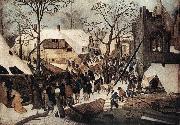 |
BRUEGHEL, Pieter the Younger -- Click Here
|
|
Flemish painter (b. 1564, Bruxelles, d. 1638, Antwerp).
Pieter Brueghel the Younger was the oldest son of the famous sixteenth-century Netherlandish painter Pieter Brueghel the Elder (known as "Peasant Brueghel") and Mayken Coecke van Aelst. His father died in 1569, when Pieter the younger was only five years old. Then, following the death of his mother in 1578, Pieter, along with his brother Jan Brueghel the Elder ("Velvet Brueghel") and sister Marie, went to live with their grandmother Mayken Verhulst (widow of Pieter Coecke van Aelst). She was an artist in her own right, and according to Carel van Mander, possibly the first teacher of the two sons. The family moved to Antwerp sometime after 1578 and Pieter possibly entered the studio of the landscape painter Gillis van Coninxloo (1544-1607). In the 1584/1585 registers of Guild of Saint Luke, "Peeter Brugel" is listed as an independent master. On November 5, 1588 he married Elisabeth Goddelet, and the couple had seven children.
He painted landscapes, religious subjects and fantasy paintings. For this last category he often made use of fire and grotesque figures, leading to his nickname "Hell Brueghel".
Apart from these paintings of his own invention, Pieter Brueghel the Younger also copied the works his father had created by using a technique called pouncing. His genre paintings of peasants lack Pieter the Elder's subtlety and humanism, and emphasize the picturesque. |
|
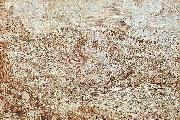 |
BRUEGEL, Pieter the Elder -- Click Here
|
|
Flemish Northern Renaissance Painter, ca.1525-1569
(born c. 1525, probably Breda, duchy of Brabant ?? died Sept. 5/9, 1569, Brussels) Greatest Netherlandish painter of the 16th century. Not much is known of his early life, but in 1551 he set off for Italy, where he produced his earliest signed painting, Landscape with Christ and the Apostles at the Sea of Tiberias (c. 1553). Returning to Flanders in 1555, he achieved some fame with a series of satirical, moralizing prints in the style of Hiëronymus Bosch, commissioned by an Antwerp engraver. He is best known for his paintings of Netherlandish proverbs, seasonal landscapes, and realistic views of peasant life and folklore, but he also took a novel approach to religious subject matter, portraying biblical events in panoramic scenes, often viewed from above. He had many important patrons; most of his paintings were commissioned by collectors. In addition to many drawings and engravings, about 40 authenticated paintings from his enormous output have survived. His sons, Peter Brueghel the Younger and Jan, the Elder Brueghel (both of whom restored to the name the h their father had abandoned), and later imitators carried his style into the 18th century. |
|
 |
BRIL, Paul -- Click Here
|
|
Flemish Baroque Era Painter, ca.1554-1626
Painter, printmaker and draughtsman, brother of Matthijs Bril. According to van Mander, Paul studied in Antwerp with Damiaan Wortelmans (1545-after 1588/9) before travelling to Rome, via Lyon, c. 1574, to join his brother, whom, according to Baglione, he assisted on Vatican commissions after 1576. However, no document places Paul in Rome before 1582, and in any case Matthijs was probably not there until c. 1575. Paul's first known independent works are monumental frescoes dating from the late 1580s. They include a dramatic rendering of Jonah and the Whale (1588) in the Scala Santa in the Vatican (based on a drawing by Matthijs; Paris, Louvre) and a series of landscape lunettes (c. 1589) in the Lateran Palace. |
|
 |
BORRASSA, Lluis -- Click Here
|
|
Spanish Gothic Era Painter, 1350-1424 |
|
 |
BORDONE, Paris -- Click Here
|
|
Italian High Renaissance Painter, 1500-1571
Bordone was born at Treviso, but had moved to Venice by late adolescence. He apprenticed briefly and unhappily (according to Vasari) with Titian. Vasari may have met the elder Bordone.
From the 1520s, we have works by Bordone including the Holy Family in Florence, Sacra Conversazione with Donor (Glasgow), and Holy Family with St. Catherine (Hermitage Museum). The St. Ambrose and a Donor (1523) is now in Brera. In 1525-6, Bordone painted an altarpiece for the church of S. Agostino in Crema, a Madonna with St. Christopher and St George (now in the Palazzo Tadini collection at Lovere). A second altarpiece, Pentecost, is now in Brera gallery.
In 1534-5, he painted his large-scale masterpiece for the Scuola di San Marco a canvas of the Fisherman delivering the Marriage Ring of Venice to the Doge (Accademia). However, when this latter painting is compared to the near-contemoporary, and structurally similar, Presentation of the Virgin, Bordone's limitations, his use of superior perspective, which creates dwarfed distant perspectives, and limited coloration relative to the brilliant tints of Titian.
Bordone is best at his smaller cabinet pieces, showing half-figures, semi-undressed men and women from mythology or religious stories in a muscular interaction despite the crowded space.
|
|
 |
BONZI, Pietro Paolo -- Click Here
|
|
ca. 1576, Cortona, d. 1636,
Roma
Pietro Paolo Bonzi (c. 1576-1636) also known as il Gobbo dei Carracci (hunchback of the Carracci) or il Gobbo dei Frutti (of fruits), was an Italian painter, best known for his landscapes and still-lifes.
he was born in Cortona, he was part of the circle of Annibale Carracci and Domenichino, and trained under Giovanni Battista Viola in Rome. In Rome, he worked for Cardinal Pier Paolo Crescenzi in Rome. There are only two still-life paintings known with his signature; he thus forms one of the first Italian artists in Rome working in this style. The Giustiniani inventories of 1638 cite paintings by Bonzi and other still-lifes are documented in the 1670 inventory of Principe Lorenzo Onofrio Colonna's collection. He also worked in fresco and in 1622-23 worked with Pietro da Cortona on the ceiling of a gallery in the Palazzo Mattei di Giove. Other commissions cited by Baglione include his work in the Palazzo Pallavicini-Rospigliosi. |
|
 |
Bonifacio de Pitati -- Click Here
|
|
painted Sacra Conversazione in 1515 |
|
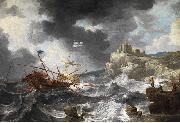 |
Bonaventura Peeters -- Click Here
|
|
(Antwerp, 23 July 1614 - Hoboken (Antwerp), 25 July 1652) was a Flemish Baroque painter who specialized in seascapes and shipwrecks, known as Zeekens (small seascapes).
Peeters, brother of the seascape painters Jan Peeters I, Gillis Peeters, and Catharina Peeters, learned to paint from his father, who became a master in Antwerp's guild of St. Luke in 1607 - 1608, and his earlier works are related to the tonal phase of Dutch landscape painting. Later paintings, however, reflect the stronger colors of Italianate classicism. This shift follows the general changes in artistic style at the time. Like his brother Jan, dramatic shipwrecks with dark billowy clouds, form a significant part of his oeuvre, as do serene ports and "portraits" of ships.Also, while many of Peeters's paintings reflect actual locations, and he may have even travelled along the coast of Scandinavia, his many views of far-away Mediterranean and Middle Eastern ports reflect a growing taste for the exotic and are probably inspired from fantasy and from prints. This tradition developed simultaneously in Flemish painting and in Dutch Golden Age painting, with many artists, including Peeters, working in both Antwerp and in the Dutch Republic. |
|
 |
Bonaguida, Pacino di -- Click Here
|
|
Italian, active 1303-1330 |
|
|
|
|
| | |
|
|
|
|